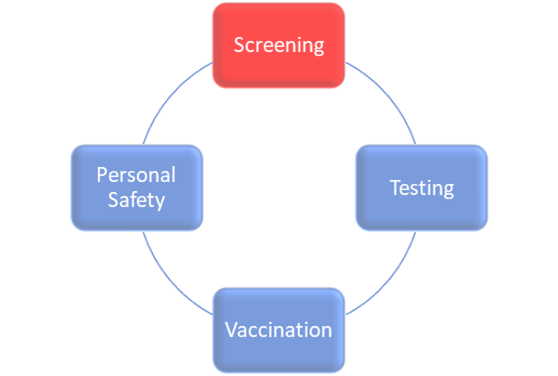By: Kartik Kumar
National Practice Leader, Municipal Government and Broader Public Sectors.
The past year has been incredibly volatile across all industries. While some industries remained steady and stable, others suffered significantly. As we begin to emerge into a post-pandemic way of life, new beginnings will always call for new leadership and new perspectives. 2020 has required an incredibly unique set of leadership skills that were constantly challenged month after month with scandals, social justice issues, quarantine and climate change to name a few.
As restrictions begin to loosen with more and more Canadians being vaccinated, there are several critical leadership qualities and competencies that will serve leaders well in the public sector for a steady, safe and final reopening across Canada. Below are some of the leadership qualities I foresee as essential for leaders to transition public sector services and organizations into a post-pandemic life.
9 Critical Skills Leaders Will Need Post-Pandemic.
Strong Digital Communicators. As we saw throughout the pandemic, timely and factual information must be distributed to reach large audiences very quickly. Future leaders will need a balance of skills to understand how to best leverage communication platforms and tools such as tweeting and texting for urgent public alerts.
Adaptability. As workforces begin to return to the office, new leaders will need to be adaptable and encourage a hybrid model of remote and in-person work. Future leaders will need to embrace this and shift the cultural perspective to value productivity over physical presence in an office. Most employees and teams understand the best ways they work and future leaders will have to flex and accommodate accordingly while keeping an eye on productivity.
Digital Transformation Champions. As workforces went fully remote for over a year, many organizations were blind-sided by this drastic shift putting an immense strain on technology and resources. This unexpected transition to entirely digital delivery for services, meetings, events and more will remain with us even after the pandemic subsides. Future leaders will need to champion and continue to support a hybrid model for digital and in-person services to their communities and citizens even post-pandemic.
Transparency and Trust. As we saw with scandals, social justice issues and even vaccination delays creeping into 2021, trust was fractured across the economy and Canada. Effective post-pandemic leaders will need to be transparent in order to build confidence and trust back up within governments, municipalities, public services and more in order to move past the severe impacts of COVID-19.
Tenacity, Courage And Resilience. Many difficult decisions were made in 2020 that riddled industries including the public and private sector. In order for municipalities to recover from these hardships in the long-term, leaders will need to be bold, tenacious and resilient. Future leaders will need to redefine their strategic direction and vision after a year of diversion, delays and disruption, and take these skill sets with them into post-pandemic planning.
Motivation And Influence. As we discussed earlier, trust and transparency will be critical to instill a renewed faith in governments and Canada’s economy. As we emerge into a more familiar way of life, strong leaders will need to motivate and influence communities to impart a feeling of safety for restarting the economy again. By providing an initial assurance of comfort and trust through transparency, strong leaders will then be tasked with pursuing this momentum and convincing communities that the end of the pandemic has arrived through influence.
Empathy. Even beyond catastrophic pandemic times, strong leaders must always remain empathetic for their teams and communities. In order to be successful, strong post-pandemic leaders must remain steadfastly empathetic and recognize the individuals and stakeholders that were essential to survival over the past 14 months. In addition, effective future leaders must be mindful and recognize the impact COVID-19 has and will continue to have on society’s mental health. By remaining vigilant to these risks and possible side effects, leaders will be able to better support the well-being of their teams and their communities across Canada.
Collaboration And Partnership. The pandemic has shown us the true benefits of collaboration and information sharing. Future leaders will need to heavily rely on partnership for building a new future together. Within the last year, there were key strategies and projects that worked well and others that were less successful. More often than not, collaboration and partnership attributed to Canada’s success during a time of volatility and future leaders will need to continue building upon these relationships through collaboration.
Innovation And Flexibility. Many municipalities, local governments and even libraries depended upon innovation to help them adapt to chaotic and unprecedented times. Post-pandemic leaders will need to lean heavily into innovation which will in turn demand flexibility. Whether leaders are tasked with finding alternative revenue streams, incentivizing workforces to return to the office or even accelerating new businesses to open and return to urban areas, creative thinking and flexibility will be a critical skill to set these initiatives in motion and course correct the future for Canada’s economy.
During the pandemic many people and communities fled cities to suburban areas for more space and a better work life balance offered by remote working. As a result, these smaller non-urban satellite “Zoom Towns” needed to adapt quickly as residency increased and their micro economies grew. Below is one such example of a small municipality that met this challenge head on, and relied heavily on their innovative leaders and agile teams to plan and prepare for this.
Modernizing For Urban Lifestyle Through Innovative Leadership
As the pandemic subsides, the question arises for those that fled urban centers in search of more space and whether or not they will remain or return to the larger cities? Some will undoubtedly return to urban life, however, others have found a renewed appreciation for life outside of the city, such as the Town of Innisfil. A recent article discussed the innovative ways that the small urban satellite Town of Innisfil, located 45 minutes outside of Toronto with a population of ~37,000, is reinventing itself through a highly nimble and flexible approach to economic development.
Today, the Town of Innisfill is challenging the status quo and applying learnings from their larger, more urban counterparts, allowing the Town to scale quickly and innovate quite literally from the ground up. The Town of Innisfil is taking new measures for transformative city planning, public transit and more with its sights set on becoming a central GovTech hub for Canada.
Within the article, Dan Taylor, Economic Development Catalyst for the Town of Innisfil said, “The reason we’re able to be quite innovative is we’re small and nimble. Our senior administration and council are fairly closely aligned. So we have great thinking in our leadership — both politically and administratively”. Taylor continued to add, “…Our Chief Administrative Officer (CAO) said, when we do economic development, we want to be an accelerator. We don’t want to just be a facilitator. We want to put our foot on the gas and really play a different role”.
In order to keep their small community thriving post-pandemic they’ve decided to innovate in a few different ways including:
- Offering economic incentives for GovTech start-ups to relocate offices and establish headquarters in the Town of Innisfil away from the larger city centers, allowing talent to remain local and drive innovation centrally.
- Planning and building an urban environment zoned using concentric circles for streets and avenues. By building the infrastructure of a modern city-within-a-town, referred to as “The Orbit”, the Town of Innisfil will offer residents the benefits of city dwelling without overdevelopment and losing the intimate feeling of the Town.
- Piloting Uber as the Town’s main official form of public transit. This on-demand format of public transit reduces costs and increases efficiency as demand increases or subsides. By leveraging an existing platform through partnership and collaboration, the Town of Innisfil was able to plan and create a new mass transit system with little infrastructure investment.
- Accepting cryptocurrencies for residents to pay taxes. The Town of Innisfil has begun accepting digital cryptocurrencies from residents to pay for taxes.
- Planning a new rail transit to connect the Town of Innisfil directly with the neighboring city of Toronto to offer streamlined commuter options and increase connectivity to the larger central Canadian hub.
The Town of Innisfil was able to innovate and set these strategic plans in place as a result of their leadership. Instead of taking the traditional approaches to economic expansion and development, senior leadership within the public sector saw an incredible opportunity for true innovation and sought out creative solutions. As an entire collective municipality, the Town of Innisfil has resources readily available to drive these fresh, new and innovative programs. However, even on a much smaller scale, innovation knows no boundaries.
Innovation Within Canada’s Public Libraries For Today And Tomorrow
Another example of innovation on a much smaller scale, are the many ways in which leaders across Canada’s public libraries transformed, adapted and innovated as they were forced from a primarily in-person model to an entirely digital resource and online service.
In a recent interview, Vickery Bowles of the Toronto Public Library system, mentioned the ways in which the Toronto Public Library had to innovate and adjust as the pandemic thrust both the private and public sector into a digital transformation spiral.
Within the interview, Bowles commented on how the library was able to adapt. “The transition to the online environment was critical for people to give them the opportunity and to make these connections”. Bowles added, “Through a lot of innovative thinking, hard work and dedication on behalf of our staff, we dropped everything and we just focused on what we needed to do as a result of being closed and rethink how we deliver our services”.
Some of the small yet innovative ways that leadership within the Toronto Public library system met these challenges included:
Developing and Delivering Programs Virtually. Through webinar and video platform technology adoption, the Toronto Public Library was able to work with their team members to innovate, launch and deliver over 550 programs to over 40,000 attendees in under 6 months. These programs ranged from children’s story hours to yoga for young adults.
Curbside Pick Up And Drop Off. To keep book services available to communities while reducing the risk and spread of COVID-19, Toronto Public Libraries allowed for members to reserve items virtually and collect items in-person from a safe distance.
Waiving Late Fees. Libraries began waiving late fees due to quarantine guidelines and restrictions set in place at the beginning of the pandemic. Interestingly enough, the Library discovered that late fees were acting as a barrier to access for lower income families and members. By eliminating late fees, Toronto Public Library usage has increased across these communities – a core mission of the Public Library.
Strengthened Digital and Municipal Partnerships. By partnering with eBook platforms and offering a digital reader option to members, library membership increased during COVID-19 as individuals sought out alternative ways to engage their minds at home. Additionally, Toronto Public Library later partnered with food banks to offer their physical library branch spaces to them for delivering food services to the shared communities that both the Library and food banks serve.
Providing Equitable Internet Access For All. Some Toronto Public Library members depend heavily upon the availability of technology and internet access to participate in government programs, online education, etc. To continue providing these members equitable access and remain connected, Toronto Public Libraries innovatively developed internet connectivity kits that include a laptop, WiFi hotspot and laptop bag. These kits were designed to deliver these resource rich services all from the safety of a member’s own home.
Many of these new digital services and methods for the Toronto Public Library will remain ongoing post-pandemic due to their success. As a result of these innovative and flexible approaches, library membership has increased during the pandemic.
As we have seen, innovation and flexibility will remain top of mind as a core leadership skill set in our post-pandemic society. However, municipalities and public sector organizations will be challenged with identifying the best leaders and candidates that have cultivated and align with these leadership attributes.
Innovation, Diversity And Inclusion.
Diversity and Inclusion has been a common thread and discussion point for many leadership teams across the public sector for over a decade at this point. New ways of adapting and growing will require fresh and new perspectives at the leadership level.
Oftentimes innovative leadership qualities are found within diversity candidates that can challenge the status quo to effectively impact change across the organization and community. Typically, diversity candidates have experienced and mitigated a lifetime of adversity and obstacles. These experiences, both professionally and personally, foster new ideas, creative thinking, innovation, agility and influence. However, the biggest challenge that the public sector faces when it comes to finding and appointing diversity talent at the leadership level includes:
- Access To Diversity Candidates
- Diversity Mandates Representation
- Elevating Inclusion To Allow Diversity To Flourish
Access To Diversity Candidates
Many municipalities see the value that diversity can bring to their leadership teams but don’t know where to start their search for this elusive talent. For many years, organizations and municipalities unknowingly created a culture of homogeneity thus shrinking their own internal talent pipelines as a source for diversity talent. Instead, public and private sector organizations must partner with external experts to help identify, appoint and present the most qualified and capable diversity candidates for leadership roles. For example, in the past year, I’ve worked with several public sector organizations and municipalities to identify, hire and onboard several strong female leaders across Canada.
Diversity Mandates Representation
One element of diversity that some organizations fall victim to is the pressure to hire a diversity candidate as a check list item to appease public demand and stakeholders for visibility reasons. I’ve worked with many clients in my career as an executive search consultant, and the key to hiring a diversity candidate that can provide the best value to the community is the simple concept of representation.
I often challenge clients, counselors and hiring committees that request a diverse slate of candidates to examine what diversity looks like within their community internally and demographically. Sometimes the personification and perception of diversity by selection committees may not always align with the true values and representation of the communities they will be serving – this is critical when considering a diversity hire at the leadership level. As a best practice, a diversity candidate should be representative of the larger community in which they will serve, while also maintaining the leadership attributes required by the role.
Elevating Inclusion To Allow Diversity To Flourish
The other caveat that municipalities and public sector organizations overlook when hiring a diversity candidate is the necessary inclusivity training and acceptance of new and different perspectives by other senior leaders. Inclusivity programs allow for the broader leadership team to adopt and best leverage new perspectives offered by diversity candidates in powerful ways. By elevating cultural sensitivities and awareness to the existing senior leadership team and creating a more inclusive culture, senior leaders can learn how to better work together and support one another. As a result, this awareness and inclusivity will increase collaboration and knowledge sharing and trickle down through the organization to more junior teams. As this cultural shift slowly takes place, success can be measured by the amount of diversity talent attracted to the organization, thus building an internal diversity talent pipeline for the future.
About The Author.

Kartik Kumar is a Partner at Legacy Executive Search Partners and has over 15 years experience in successfully executing 250 projects within the Public and Private sector, including municipal government and public libraries. Kartik has a Bachelor’s in Business Management from Ryerson University and an accredited certification in Diversity and Inclusion from Cornell University.
Prior to joining Legacy Executive Search Partners, Kartik has held several Managing Director roles within large national and international executive search firms. He has successfully developed an executive search practice across Ontario and Canada within Municipal Government and the Broader Public sector.
Contact Kartik Kumar at [email protected] for Senior Leadership Recruitment within the Public Sector across Canada.












